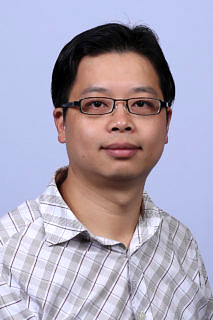Dr. Xiaoming He

Humboldt Research Fellow at the Chair for Computer Science 10 (System Simulation)
Dr. Xiaoming He from China obtained a Bachelor in Science and a Master in Science in Computational Mathematics at Sichuan University from 1998 to 2005. From 2005 to 2007, he was a student of the Master in Science in Mathematics at the Virginia Tech, where he also completed his Ph.D. from 2005 to 2009. Furthermore, Dr. He was a postdoctoral research associate at the Department of Scientific Computing at Florida State University from 2009 to 2010 and has been assistant professor and then associate professor at the Department of Mathematics and Statistics at the Missouri University of Science and Technology from 2010 to date.
Additionally, Dr. He played a vital part in founding the SIAM (Society for Industrial and Applied Mathematics) Centrals States Section. The SIAM Central States Section was formed in 2014 and serves SIAM members in Arkansas, Colorado, Iowa, Kansas, Mississippi, Missouri, Nebraska, and Oklahoma. Its purpose is to enhance the communication among the section members and to promote the collaboration for both basic research and applications of mathematics to industry and science among others. From 2014 to 2016, Dr. He hold the position of the Founding President of the section.
Dr. He´s research interests are comprehensive and range from computational fluid dynamics to particle models for plasma simulation. From March to August 2018, he will further is studies at the Institute for Informatics 10 (System Simulation) at FAU.
Any researcher who wants to extend a creative research collaboration should come to FAU
What exactly sparked your interest in this field of research?
The wide range of important real world applications for the coupled multi-phase fluid and porous media flows and the significant challenges in all of modelling, computation, and mathematical analysis.
What would you say to students or young researchers who are considering choosing FAU for a stay abroad?
Any researcher who wants to extend a creative research collaboration should come to FAU, because there is a very open and creative environment for exchanging thoughts and triggering novel ideas.
How well known is FAU internationally in your field of research?
Very well known, especially due to the works of the group of my host, Prof. Dr. Ulrich Rüde, head of the Chair for Computer Science 10 (System Simulation) at FAU.
How do you find the interaction between researchers at FAU?
I had plenty of efficient and fruitful interactions with other researchers and visiting scholars at FAU.
Could you give us a short description of the project your research group is working on?
We plan to carry out systematic research on a novel mathematical modelling , which is called phase field modelling, for the coupled multi-phase fluid and porous media flows. We will develop, analyse, compare, and apply two types of numerical methods to efficiently and accurately solve the governing equations in parallel.
What is your main task within your project?
The mathematical modelling, the development of the numerical methods, and the corresponding mathematical analysis for both modelling and numerical methods.
What are the most important results of your research at FAU to date?
To propose and analyze a multi-phase coupling model with varying density as well as to develop an efficient decoupling method to solve the proposed model. Furthermore, to propose several interesting ideas, which are inspired by the existing works, to investigate a particle model, the so called lattice Boltzmann model, for the coupled multi-phase fluid and porous media flows.
How does your research benefit or affect society?
There are many important applications that involve coupling a fluid flow and a porous medium flow, such as the subsurface flow system in a karst aquifer, industrial filtration, and petroleum extraction. The success of building, solving, and analyzing the frontier models, the Cahn-Hilliard-Navier-Stokes-Darcy system and the large scale lattice Boltzmann system, will significantly improve our capability to deal with this type of complex coupled flows. These models and the general framework for the efficient decoupling method can be readily extended to a wide range of problems in various related fields.
What were your first (and subsequent) impressions of the Erlangen-Nuremberg region?
Nice environment for living and working and a religious and historic region.
FAU has very nice and helpful staff members.
Can you already tell us a highlight, a moment from your stay, which you find particularly memorable?
The moment when I was able to understand the basic idea of the lattice Boltzmann method, which is a novel particle method for computational fluid dynamics, and when I came up with the interesting idea to connect the works on the traditional macro-models with the lattice Boltzmann method. Since my traditional research works in computational fluid dynamics focus on the macro models, the lattice Boltzmann method has significantly expanded my view and capability for computational fluid dynamics from the side of particle models.
What are your favourite places at FAU and in Erlangen or Nuremberg?
My office.
Is there anything else you would like to mention?
FAU has very nice and helpful staff members. The university guesthouse is also very convenient since it is close to my office.
Thank you for the interview, Dr. He.